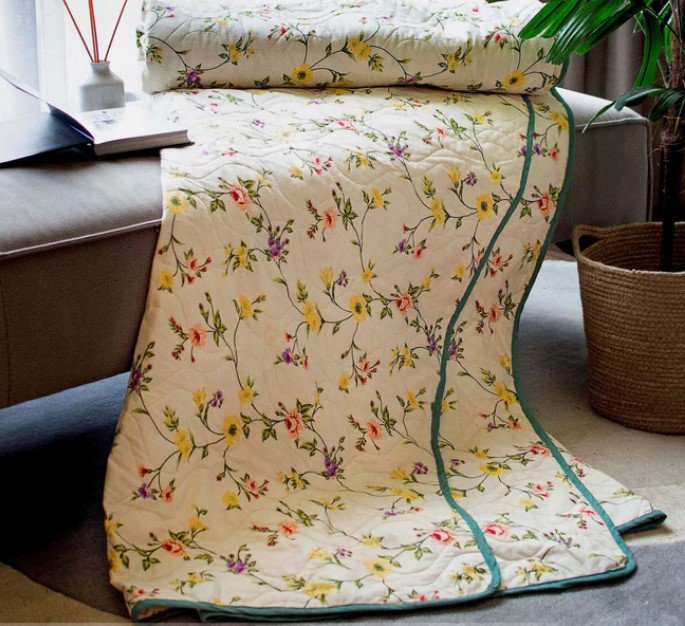A quilt is more than just a decorative element in your bedroom; it is a functional piece of bedding that offers warmth, comfort, and style. Among various options, single cotton quilts are particularly favored for their versatility and breathability. This guide will explore the benefits of cotton quilts, different types and styles, care tips, and how to choose the perfect one for your needs.
1. Benefits of Single Cotton Quilts
- Comfort
Cotton quilts provide a soft, cozy surface that enhances your sleeping experience. The natural fibers are gentle on the skin, making them ideal for people with sensitivities or allergies.
Breathability
Cotton is known for its breathability, allowing air to circulate and helping to regulate body temperature. This feature is especially beneficial for those who tend to sleep hot.
- Durability
High-quality cotton quilts can last for many years when properly cared for. Cotton fibers are strong and resistant to wear and tear, making them a worthwhile investment.
- Hypoallergenic
Cotton is naturally hypoallergenic, which means it’s less likely to trigger allergic reactions. This makes cotton quilts a good choice for individuals with asthma or allergies.
- Easy Care
Cotton quilts are generally machine washable and easy to maintain, allowing for hassle-free cleaning and upkeep.
Also Read: A Guide to Choose the Best Quilt for Heavy Winter
2. Types of Cotton Quilts
When choosing a single cotton quilt, it’s essential to understand the various types available:
- Patchwork Quilts
Description: Made from pieces of fabric sewn together in intricate designs, often telling a story or reflecting a theme.
Aesthetic: Offers a rustic or vintage feel, perfect for traditional or country-style decor.
- Printed Quilts
Description: Feature designs printed directly onto the fabric, available in a variety of patterns and colors.
Aesthetic: Ideal for adding a pop of color or pattern to modern or contemporary spaces.
- Solid Color Quilts
Description: Simple quilts made from a single color or a few coordinating colors.
Aesthetic: Provides a minimalist and clean look, making them versatile for various decor styles.
- Quilted Throws
Description: Smaller than traditional quilts, these are perfect for draping over a chair or for use as a lightweight cover.
Aesthetic: Great for adding texture and warmth without overwhelming a space.
- Lightweight Quilts
Description: Designed for warmer climates or summer use, these quilts are thinner and provide just enough coverage.
Aesthetic: Often feature breathable fabrics and light patterns, perfect for casual settings.
3. Choosing the Right Single Cotton Quilt
Selecting the ideal cotton quilt involves several considerations:
- Size
A single cotton quilt typically measures around 66 x 90 inches, but it’s essential to check the specific dimensions of your bed to ensure a proper fit. If you prefer your quilt to hang over the sides, consider a slightly larger size.
- Thread Count
While thread count is more commonly discussed in sheets, it can also apply to quilts. Generally, a higher thread count indicates a softer fabric. Look for quilts with a thread count of at least 200 for comfort.
- Fill Material
The fill of the quilt can affect its warmth and weight. Common fill materials include:
Cotton Batting: Provides a natural feel and breathability.
Synthetic Fill: Often lighter and less expensive, but may not offer the same breathability.
- Design and Color
Choose a design and color scheme that complements your bedroom decor. Consider whether you want a bold pattern or something more subtle that blends in.
- Quality
Check the quality of stitching and overall construction. A well-made quilt will have even stitching and strong seams, ensuring it holds up over time.
4. Caring for Your Cotton Quilt
To maintain the longevity of your cotton quilt, proper care is essential:
- Washing
Frequency: Wash your quilt every few months, or more often if it’s heavily used or soiled.
Temperature: Use cold or warm water to prevent shrinkage and fading. Hot water can be used if needed for sanitation.
- Detergent
Choose a gentle detergent that’s free of harsh chemicals or bleach to protect the fabric.
- Drying
Air Drying: If possible, hang your quilt to air dry. This method is the gentlest and helps maintain the quilt’s shape.
Tumble Drying: If using a dryer, select a low heat setting to prevent damage. Adding dryer balls can help fluff the quilt during drying.
- Ironing
If your quilt becomes wrinkled, use a steam iron on a low setting. Always check the care label for specific ironing instructions.
5. Environmental Impact of Cotton Quilts
While cotton is a natural fiber, its production can have environmental consequences. Here are some aspects to consider:
- Water Consumption
Cotton farming requires a significant amount of water. Choosing organic cotton quilts can help reduce the environmental impact, as they are often produced using more sustainable practices.
- Pesticides
Conventional cotton farming frequently involves the use of pesticides and chemicals that can harm ecosystems. Opting for organic or sustainably sourced cotton can help mitigate this issue.
- Certifications
Look for certifications such as GOTS (Global Organic Textile Standard) or OEKO-TEX, which ensure that the cotton used has been produced responsibly and without harmful substances.
6. Customizing Your Cotton Quilt
If you want something unique, consider customizing your cotton quilt:
- Custom Sizes
Some companies offer made-to-order quilts, allowing you to specify the dimensions you need for your bed.
- Personalized Designs
You can choose colors, patterns, and even add monograms or personalized messages to create a quilt that truly reflects your style.
7. Trends in Cotton Quilts
Staying updated on trends can help you find a quilt that suits your personal style:
- Sustainable Fabrics
The trend towards sustainability is growing, with more brands offering organic and eco-friendly cotton options.
- Layering
Layering quilts with other bedding, such as throws and blankets, is becoming popular. This adds depth and visual interest to your bedroom.
- Bold Patterns
- rom geometric prints to floral designs, bold patterns are making a statement in modern quilt designs.
- Minimalist Aesthetics
Simple, solid-colored quilts that emphasize clean lines and minimalism are trending, appealing to those who prefer a more understated look.
Conclusion
A single cotton quilt is not just a practical addition to your bedding but also an opportunity to express your style and enhance your bedroom’s comfort. By understanding the various types of cotton quilts, their benefits, and how to care for them, you can make an informed decision that suits your personal preferences and needs.
Whether you prefer the charm of a patchwork quilt, the elegance of a solid color, or the warmth of a lightweight option, there is a cotton quilt out there for you. Embrace the comfort and beauty of cotton quilts, and enjoy the perfect blend of functionality and style in your sleeping space.









